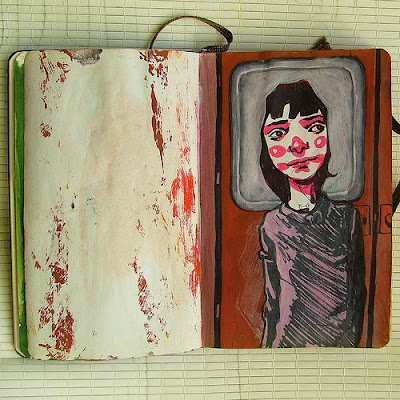

Rebecca Hossack Art Gallery: Steven Nederveen





















The People's Building at the World Expo 2010, in Shanghai,China.
The Povo Building (codename: REN for its similarity in the Chinese character for "people") is a project of a group of danish architects and designers named BIG (Bjarke Ingels Group)


























 Time for another personal photo on here... this one can be credited to my quick-on-the-shutter husband. Ellie stands still about as long as a bumblebee, so we were pretty happy with this shot, all things considered. We dropped her off for her first day of pre-school about an hour and a half ago and have less than two hours remaining until we go and pick her up! Back to work!
Time for another personal photo on here... this one can be credited to my quick-on-the-shutter husband. Ellie stands still about as long as a bumblebee, so we were pretty happy with this shot, all things considered. We dropped her off for her first day of pre-school about an hour and a half ago and have less than two hours remaining until we go and pick her up! Back to work!Washington outlawed nuclear trade with India when Delhi tested a device in 1974, the pact now would lift the ban and supply fuel and reactor technology for civilian programs, even though India has refused to sign the Nuclear Non-Proliferation Treaty.
June 26, 1946 Pandit Jawaharlal Nehru, soon to become independent India's first Prime Minister, expresses hope that his country will harness nuclear power and develop nuclear weapons
18 May, 1974 First Indian nuclear device tested
July 18, 2005. President Bush and Indian Prime Minister Manmohan Singh made a joint statement regarding civilian nuclear energy cooperation, overturning three decades of US policy (http://www.whitehouse.gov/news/releases/2005/07/20050718-6.html)
August 2007. India and the United States finalized the terms and a bilateral 123 Agreement concerning peaceful use of nuclear energy was unveiled (http://www.state.gov/r/pa/prs/ps/2007/aug/90050.htm)
August 2007 Communist allies of Indian Government threaten to withdraw support over the pact, saying that it compromises sovereignty
October 2007 Snap election averted in India after Government agrees to delay approaching the International Atomic Energy Agency with the accord (necessary step to seal deal)
Feburary 2008 United States steps up pressure on India to close deal
July 2008 Coalition talks in India fail. Indian leaders swapping allies to push the deal. The Congress Party is replacing its leftist allies, led by the Communist Party, with a coalition led by the Samajwadi, a North Indian socialist party. The Congress Party’s grip on India is weakening as inflation and fuel prices rise and the economy slows, and securing an ally is crucial to staying in power. Left calls for vote of no confidence. India submits accord to the IAEA
July 10, 2008 Singh calls for vote of confidence
July 22, 2008 Indian government survived a parliamentary no-confidence vote with the margin of merely 19 votes.
August 1, 2008. IAEA Approves Inspections Plan Required for India-U.S. Nuclear Deal
India agrees to allow inspectors from the International Atomic Energy Association (IAEA), the United Nations' nuclear watchdog group, access to its civilian nuclear program. But India would decide which of its many nuclear facilities to classify as civilian. By March 2006, India promised to place fourteen of its twenty-two power reactors under IAEA safeguards permanently. India also promised that all future civilian thermal and breeder reactors shall be placed under IAEA safeguards permanently. Teresita Schaffer, director of the South Asia program at the Center for Strategic and International Studies, says these will now include domestically built plants, which India has not been willing to safeguard before now. Military facilities—and stockpiles of nuclear fuel that India has produced up to now—will be exempt from inspections or safeguards.
India commits to signing an Additional Protocol (PDF)—which allows more intrusive IAEA inspections—or its civilian facilities.
India agrees to continue its moratorium on nuclear weapons testing.
India commits to strengthening the security of its nuclear arsenals.
India works toward negotiating a Fissile Material Cutoff Treaty (FMCT) with the United States banning the production of fissile material for weapons purposes.India agrees to prevent the spread of enrichment and reprocessing technologies to states that don't possess them and to support international nonproliferation efforts.
U.S. companies will be allowed to build nuclear reactors in India and provide nuclear fuel for its civilian energy program.
India would be eligible to buy U.S. dual-use nuclear technology, including materials and equipment that could be used to enrich uranium or reprocess plutonium, potentially creating the material for nuclear bombs. It would also receive imported fuel for its nuclear reactors.
IAEA Director General Mohamed ElBaradei : "This agreement is an important step towards satisfying India´s growing need for energy, including nuclear technology and fuel, as an engine for development. It would also bring India closer as an important partner in the non-proliferation regime," he said. "It would be a milestone, timely for ongoing efforts to consolidate the non-proliferation regime, combat nuclear terrorism and strengthen nuclear safety. The agreement would assure India of reliable access to nuclear technology and nuclear fuel. It would also be a step forward towards universalisation of the international safeguards regime. This agreement would serve the interests of both India and the international community."
Bring India closer to U.S. - Nuclear partnership
Ashley Tellis of the Carnegie Endowment for International Peace—currently serving as an adviser to the State Department on Indian affairs—says in congressional testimony that the deal recognizes this growing relationship by engaging India, which has proven it is not a nuclear proliferation risk.
Philip D. Zelikow, a former top aide to Secretary of State Condoleezza Rice, said in an interview that the deal posed "the most significant issue of international engagement" in a generation and could one day represent "one of the most consequential things this administration did."
for India: Energy
India has limited coal and uranium reserves and deepening energy needs. It hopes that by 2050 nuclear power can provide up to 25 percent of its electricity.
for the nuclear nations: Making Money.
The Washington Post reports: "experts say India plans to sink up to $100 billion into its civilian nuclear industry over the next 20 years. Several nuclear-armed nations, including the United States, France and Russia, are vying for a chunk of that business".
In terms of International Relations:
Encourage India to accept international safeguards on facilities it has not allowed to be inspected before. This is a major step, experts say, because the existing nonproliferation regime has failed either to force India to give up its nuclear weapons or make it accept international inspections and restrictions on its nuclear facilities. "President Bush's bilateral deal correctly recognizes that it is far better for the nonproliferation community if India works with it rather than against it," writes Seema Gahlaut of the University of Georgia's Center for International Trade and Security in a CSIS policy brief. IAEA Director-General Mohammed ElBaradei has strongly endorsed the deal, calling it a pragmatic way to bring India into the nonproliferation community.
Recognize India's history of imposing voluntary safeguards on its nuclear program. Proponents of the deal say India has an excellent record of setting credible safeguards on its nuclear program for the last thirty years. After the safeguards on the U.S.-supplied Tarapur nuclear facility expired in 1993, for example, India voluntarily established a new agreement with the IAEA to continue the restrictions.
Recognize that India has a good record on proliferation. Although it is not a signatory to the NPT, India has maintained strict controls on its nuclear technology and has not shared it with any other country. Proponents of the deal say this restraint shows that India, unlike its nuclear neighbor Pakistan, is committed to responsible nuclear stewardship and fighting proliferation. In May 2005 India passed a law, the WMD Act, which criminalizes the trade and brokering of sensitive technology.
Reward India's decision to adopt similar nuclear export standards as those imposed by the Nuclear Suppliers Group (NSG). India has thus far chosen to abide by the strict export controls on nuclear technology set by the NSG, a group of forty-five nuclear-supplier states that voluntarily coordinates controls of nuclear exports to non-nuclear-weapon states. Experts say if India chose to lift these voluntary restrictions, it could easily sell its technology to far less trustworthy countries around the world. The U.S. deal would reward the Indian government for its voluntary controls and give New Delhi incentive to continue them, against the demands of Indian hardliners who question what India gets out of placing such limits on itself.
Opposing:
Reversal of half a century of U.S. nonproliferation efforts, undermine attempts to prevent states like Iran and North Korea from acquiring nuclear weapons, and potentially contribute to a nuclear arms race in Asia. “It's an unprecedented deal for India,” says Charles D. Ferguson, science and technology fellow at the Council on Foreign Relations. “If you look at the three countries outside the Nuclear Non-Proliferation Treaty (NPT)—Israel, India, and Pakistan—this stands to be a unique deal.”
U.S. can’t make money from it. Business Weekly: “The problem is, the Americans may get little from the deal. Instead, Paris-based Areva and two Russian companies are poised to exploit long-standing ties to New Delhi to win the lion's share of the work on the 30 or so reactors the Indians hope to build, at a total cost of some $100 billion. The Russians are already helping to build one reactor, and Areva appears likely to get a contract for another. "Historically, Russia has been a more consistent ally for India, and the French have the advantage of being world leaders in nuclear technology," says Padmanabha Chari of the Institute for Peace & Conflict Studies, a Delhi think tank.”
Lack sufficient safeguards to prevent New Delhi from continuing to produce nuclear weapons. "We are going to be sending, or allowing others to send, fresh fuel to India—including yellowcake and lightly enriched uraniumt—that will free up Indian domestic sources of fuel to be solely dedicated to making many more bombs than they would otherwise have been able to make," says Henry Sokolski, executive director of the Nonproliferation Policy Education Center, a nonprofit organization dedicated to improving awareness of proliferation issues. **India claimed it was using nuclear technology for civilian purposes right up until its first nuclear weapons test in 1974. A Congressional Research Service report on the agreement states, "There are no measures in this global partnership to restrain India's nuclear weapons program."[http://www.fas.org/sgp/crs/row/RL33016.pdf]
- The safeguards apply only to facilities and material manufactured by India beginning when the agreement was reached. It doesn't cover the fissile material produced by India over the last several decades of nuclear activity. The CRS report says, "A significant question is how India, in the absence of full-scope safeguards, can provide adequate confidence that U.S. peaceful nuclear technology will not be diverted to nuclear weapons purposes."
- The deal does not require India to cap or limit its fissile material production. This comes at a time when nearly all the major nuclear powers—including the United States, France, Britain, and Russia—are moving to limit their production.
- The deal does not require India to restrict the number of nuclear weapons it plans to produce.
There are far more cost-efficient ways to improve India's energy and technology sectors. These could include making India's existing electricity grid more efficient, restructuring the country's coal industry, and expanding the use of renewable energy sources, Sokolski said in congressional testimony. All these steps would involve much less dangerous transfers of technology that would not be dual-use, and therefore not convertible to nuclear weapons production.
The agreement was rushed and takes unnecessary risks without adequate preparation or expert review. The agreement "appears to have been formulated without a comprehensive high-level review of its potential impact on nonproliferation, the significant engagement of many of the government's most senior nonproliferation experts, or a clear plan for achieving its implementation," writes William C. Potter, director of the Center for Nonproliferation Studies at the Monterey Institute of International Studies, in Nonproliferation Review. "Indeed, it bears all the signs of a top-down administrative directive specifically designed to circumvent the interagency review process and to minimize input from any remnants of the traditional 'nonproliferation lobby.'"
The final terms of the nuclear deal need approval from several sources before they can be implemented. The bodies required to approve the deal include:
India's Parliament. check, after political instability and struggle
The Nuclear Suppliers Group. ( conference in Vienna on August 21, 2008) The NSG tries to restrict the spread of nuclear technology that could be used in weapons programs through export controls. The United States will try to convince the group to make an exception for India, which may be a difficult case to make when the United States is simultaneously trying to prevent Iran and North Korea from gaining similar access to nuclear fuel and technology.
Congress. Under the U.S. Atomic Energy Act, which regulates the trade of nuclear material, congressional approval is needed to pass the exemptions to U.S. laws required for the nuclear deal to be implemented. Members of Congress are showing resistance, with some calling for India to commit to strict limits on its nuclear weapons program before the deal goes through. "Congress needs to address the many troubling questions raised by this deal before it considers changing longstanding nonproliferation laws," David Albright, president of the Institute for Science and International Security, said in congressional testimony in October 2005. Problem is, according to Washington Post: There isn't much time; under U.S. law, Congress must be in session continuously for 30 days to consider the deal. Before that clock can start, the 45-nation Nuclear Suppliers Group must give India a green light. While the approval is likely, they won't happen instantaneously. And because of the long August recess, there may not be more than 30 "legislative days" left before Congress adjourns on Sept. 26. The deal raises many legitimate questions. But, on balance, it is in the United States' interest, and Congress should find the time to say yes -- in a lame-duck session after the November election, if necessary.
It could gut the agreement, experts say. Article 1 of the treaty says nations that possess nuclear weapons agree not to help states that do not possess weapons to acquire them. Albright says that without additional measures to ensure a real barrier exists between India's military and civilian nuclear programs, the agreement "could pose serious risks to the security of the United States" by potentially allowing Indian companies to proliferate banned nuclear technology around the world. In addition, it could lead other suppliers—including Russia and China—to bend the international rules so they can sell their own nuclear technology to other countries, some of them hostile to the United States. On the other hand, experts like Gahlaut argue the NPT was already failing in its mission to prevent proliferation. She says many countries—including North Korea, Libya, Iran, and Iraq—have cheated while being signatories of the NPT.
It is a motivating factor in the deal, some experts say. China's rise in the region is prompting the United States to seek a strategic relationship with India. "The United States is trying to cement its relationship with the world's largest democracy in order to counterbalance China," Ferguson says. The Bush administration is "hoping that latching onto India as the rising star of Asia could help them handle China," Sokolski says. But other experts say the growing economic relationship between China and India is so critical to New Delhi that its interests in China cannot be threatened or replaced by any agreement with the United States. Indians "have no interest whatsoever in trying to contain China because they believe this could be a self-fulfilling prophesy, and their whole policy is to seek the best possible relationship with China," Robert Blackwill, a former U.S. ambassador to India, said at a Council meeting February 23. Other experts worry U.S. nuclear aid to India could foster a dangerous nuclear rivalry between India and China. Though India has a strong interest in building economic relations with China, New Delhi is still wary of China's military rise in the region.
Pakistan's President Pervez Musharraf, who has suffered fierce criticism at home—and survived two assassination attempts—or his strong alliance with the United States since 9/11, has not received a similar deal on nuclear energy from Washington. Some experts say this apparent U.S. favoritism toward India could increase the nuclear rivalry between the intensely competitive nations, and potentially raise tensions in the already dangerous region. "My impression is that [the Pakistanis] are worried this will feed the Indian nuclear weapons program and therefore weaken deterrence," Blackwill said. Other experts say the two countries, both admittedly now nuclear, could be forced to deal more cautiously with each other. Pakistan is already a proliferation risk: Pakistani nuclear scientist A.Q. Khan's illicit nuclear network, revealed in 2004, shocked the world with its brazen trade of nuclear technology. Some experts worry the U.S.-India deal could prompt Pakistan to go elsewhere for similar terms.
In the 1950s, the United States helped India develop nuclear energy under the Atoms for Peace program. The United States built a nuclear reactor for India, provided nuclear fuel for a time, and allowed Indian scientists study at U.S. nuclear laboratories. In 1968, India refused to sign the NPT, claiming it was biased. In 1974, India tested its first nuclear bomb, showing it could develop nuclear weapons with technology transferred for peaceful purposes. As a result, the United States isolated India for twenty-five years, refusing nuclear cooperation and trying to convince other countries to do the same. But since 2000, the United States has moved to build a "strategic partnership" with India, increasing cooperation in fields including spaceflight, satellite technology, and missile defense.






